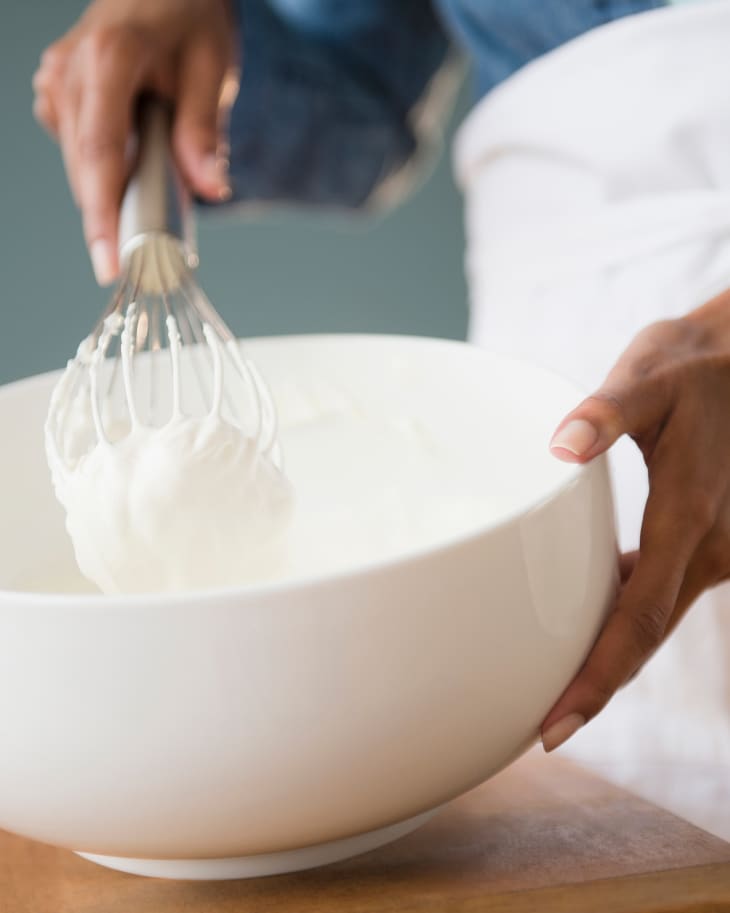Heavy Cream, Whipping Cream, Half & Half, and Light Cream: What’s the Difference?
There are a daunting number of cardboard pints and quarts of different cream varieties at the grocery store. Which is which? Is there a difference between them? Here’s a complete rundown so you won’t find yourself scratching your head the next time you’re in the dairy aisle.
The Difference Between Heavy Cream, Whipping, Cream, Light Cream and Half-and-Half?
The U.S. Food & Drug Administration sets specific standards for each type of cream. The difference between these four common cream varieties is really just the amount of fat they contain.
- Heavy cream contains 38 percent fat
- Whipping cream contains 35 percent fat
- Light cream contains 20 percent fat
- Half-and-half contains 12 percent fat
The higher the fat content, the thicker the cream, and the easier it is to whip into stable peaks (or whipped cream). Higher-fat creams are also more resistant to curdling, so they are a better choice in soups and sauces, when the cream is heated. Whenever you’re confused, just remember: Cream that’s labeled “heavy” contains more fat.
If you’re trying to avoid cream with higher fat for a particular reason, try the cream with the fat content just below the one called for, as it will be the closest substitute, before experimenting with lighter creams.
What Is Heavy Cream?
At the top of the charts is heavy cream, sometimes also called heavy whipping cream, which contains about 38 percent fat. It’s pretty much indistinguishable from whipping cream — both can be whipped or added to soups and sauces without the risk of curdling.
What Is Whipping Cream?
Now we’re getting into high-fat territory. At a hefty 35 percent fat, whipping cream can indeed be whipped into luscious peaks for all your cake and pie dolloping needs. It’s also rich enough that it won’t curdle when heated in soups and sauces. It’s nearly identical to heavy cream (see above), so if a recipe calls for heavy cream and you can only find whipping cream, feel free to use that instead.
Best uses for heavy cream or whipping cream:
- Whip it to make no-churn, 2-ingredient ice cream.
- Layer it with graham crackers and fruit for a simple but stunning icebox cake.
- Stir a splash into soup.
- Make a quick and foolproof Alfredo sauce.
- Drizzle some over your morning bowl of oats.
What Is Light Cream?
One step up is light cream, which contains about 20 percent fat. While richer than half-and-half, it still doesn’t contain enough fat to be whipped, so it’s a good choice if you want even more creaminess in your coffee. It’s also an easy way to elevate a simple dessert. Light cream could potentially curdle when a substantial amount is heated in a soup or sauce.
Best uses for light cream
- Drizzle it over dessert like pound cake or fruit crisps and crumbles.
- Add a splash to scrambled eggs before cooking them — the result will be extra creamy.
What Is Half-and-Half?
Half-and-half is exactly what it sounds like, equal parts whole milk and light cream. It contains about 12 percent fat, which makes it richer than whole milk (which contains 3.5 percent fat), although less rich than light cream. This makes it a popular addition to coffee because it lends a little more richness to the cup than whole milk does, but not as much as cream. It doesn’t, however, contain enough fat to be whipped.
Best uses for half-and-half:
- Enjoy it in your mug of coffee for added richness.
- Try using it in desserts that call for equal parts milk and cream, like panna cotta.
